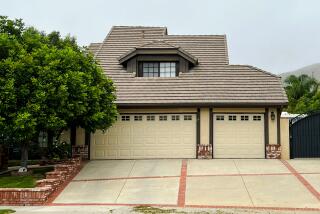Breuer house a lesson on sales
- Share via
NEW YORK -- Artist David Diao says, “I was the beginning,” and he doesn’t mean it in a good way.
First he bought a Marcel Breuer-designed house -- a novel home, for sure, designed around a sleek aluminium Spartan Trailer -- on 15 acres two hours upstate. Then he fixed it up. Then he figured he’d found the perfect time to sell it, and the perfect method, when the auctioning of Midcentury Modernist homes became the rage, or a mini-trend at least.
But when he says “I was the beginning . . . ,” he quickly elaborates, “. . . of the ones that didn’t go through,” portraying his experience as a first signal that auctioning off such homes as works of art might not be the brainstorm it seemed.
In fact, his Breuer-designed Wolfson House did draw a $1-million minimum bid last October at the highly promoted sale by Chicago-based auctioneer Richard Wright. But the buyer had never seen the actual home -- just the photos assembled by the auction house. Then he visited . . . and backed out.
Wright won’t say exactly what went wrong, and Diao isn’t sure. But both have a new perspective on the experience now that two other auctions of architecturally significant homes have had similarly unsatisfactory results.
“Yes, I’ve followed that with fascination,” says Diao, who works many weekends in a studio almost adjoining the Breuer home, as does his wife, Maureen Connor, who creates video installations.
Longtime residents of Manhattan’s TriBeCa neighborhood, they were not looking for a country retreat, Diao said, when they learned that the Breuer house was for sale in 1996. But the China-born Diao had taught for years at an extension program run by the Breuer-designed Whitney Museum and couldn’t resist. “The fact that there was a Breuer I could afford dazzled me,” the 64-year-old artist recalled. “I didn’t really think much ahead.”
The Hungarian-born Breuer, a mainstay of the Bauhaus school, was perhaps best known for his furniture, particularly his simple, tubular steel chair. He also designed institutional buildings, such as the Whitney and the curving UNESCO Headquarters in Paris, as well as two dozen homes in the United States. The one that had Diao’s eye was unquestionably unique. At the request of the original property owner, Sidney Wolfson, Breuer designed the structure in 1949 around one of the gleaming trailers then being manufactured by oilman J. Paul Getty’s Tulsa-based Spartan Aircraft Co. Indeed, a 1947 model trailer was installed next to the home’s stout stone base, above which sat the glass-walled rectangular main living area.
The reason it was so affordable a half century later, however, was its condition. “I basically had to completely redo everything to the outside,” Diao said, “and the kitchen.”
He and his wife settled into a pattern of heading up to Dutchess County property on weekends and staying in the separate studio, with its own wide set of windows, from which they could look out on the Breuer structure while putting guests in it, or even renting it out.
But after Wright had success auctioning off another Modernist home in late 2006, and with Christie’s having achieved some eye-opening sales as well, Diao figured that might be a way to make a healthy profit or at least get his investment back. So they set the estimated price from $1 million -- “the break-even point,” he said -- to $1.5 million, then got a bid at the low end during the phone-in auction conducted out of Chicago.
“Then the guy who actually bid on it never saw the house until the following week,” said Diao, who believes that the would-be buyer had not told his wife what he was doing.
Today, after being one of the biggest boosters of the auctioning of such houses, Wright rattles off a series of practical obstacles to what he now downplays as a “very small trend.” In a traditional real estate transaction, he notes, the buyer has equal power to the seller, if not more, while in an auction the terms are basically set in stone by the seller. Another hitch is how buyers have to pay the substantial auction house premium in sales done this way, whereas regular real estate commissions are part of the sales price. Then there are the little ways in which buying a house is different from buying a sculpture, “the maintenance, the property taxes, checking for radon gas . . . timing of the closing . . . what are the fixtures?”
“A real estate transaction is a far more complicated transaction,” summed up Wright, who isn’t sure whether he will try to sell another home this way.
Where does that leave the Breuer house with the aluminium trailer tucked under it?
It’s still for sale, Diao reports -- but through a local real estate agent. And for $1.5 million, “$1.488 million, actually.”
Diao does not sound bitter about the experience, however, and even recounts one side benefit -- on his paintings. Modernist homes started finding their way into his works.
One highlighted the Modernist houses in New Canaan, Conn., to protest how some were being demolished. Another of his paintings was influenced by Philip Johnson’s famous Glass House in that community. Diao was fascinated to learn how the rug there kept getting smaller every time it was cleaned, and also how Johnson was so anal about where the furniture should go, specifying the positioning in blueprints.
His painting thus showed a sequence of images, “beginning with the rug in the original position. And in the last frame the pieces of furniture are all on top of each other because the rug has shrunk so much.”
More to Read
The biggest entertainment stories
Get our big stories about Hollywood, film, television, music, arts, culture and more right in your inbox as soon as they publish.
You may occasionally receive promotional content from the Los Angeles Times.










